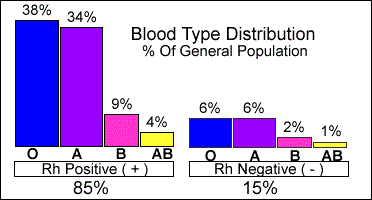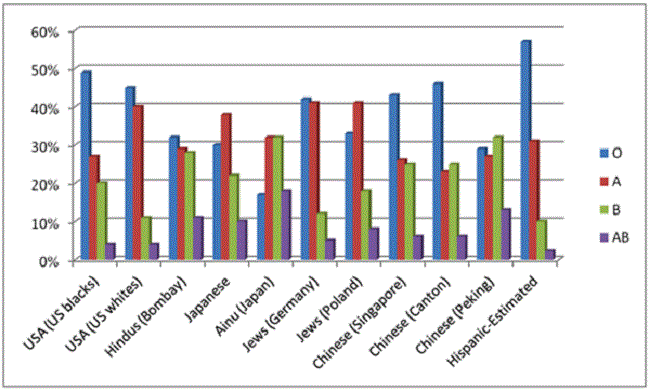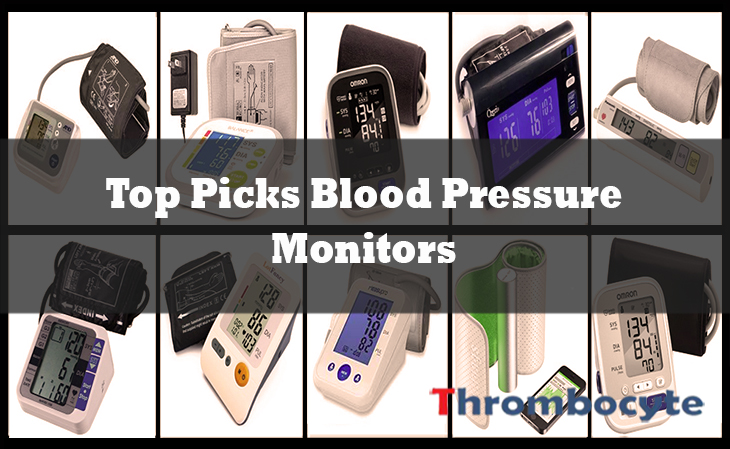What is the Most Common Blood Type
Have you ever wondered why people around the world have different blood type one from another?
In fact, even family members can have different blood types. You should be lucky if yours is the most common blood type, which is the type “O”.
Having a common blood type is very beneficial when the person becomes ill and needs blood transfusion. It is more convenient and easy to seek for donors or process application for the blood type in blood banks.
How does blood typing work? When asking your parents why do you have a different blood type compared to any one of them or totally different to both of their blood types – they may not be able to give you a specific answer.
There are actually 4 major blood types: type A, B, AB, and O where the most common type is “O”.
Blood Type Percentages Chart

Based on the figures above, it’s straightforward that the most common blood types are O and A.
*The plus and minus signs in the image above refers to Rhesus factor. You can learn about it here.
The Most Common Blood Type
You’ll find below a few factors on how a particular blood type is formed which has made “O” the most common blood type.
1. Blood Type A in Both Parents
If both of your parents have blood type “A”, then your blood type will either be type “A” or “O”.
It means that even if none of your parents is type “O” as indicated above, you can still have the most common blood type.
2. Blood Type O in Both Parents
You will definitely get the blood type “O” if both of your parents are type “O” and you will not possibly have any different blood type other than type “O”.
3. Blood Type B in Both Parents
You can have blood type “O” even if both of your parents are type “B”.
But type B parents can also end up to having a type “B” offspring.
4. Blood Type AB in Both Parents
If both parents are blood type AB, Blood Type O becomes only possible in grandchildren.
You can either get type “A”, “B”, or “AB” if both of your parents are type “AB”.
As you can see, there is zero probability of getting type “O”.
But once you start building your own family, the possibility now exists that a child of yours will be type “O”.
5. Blood Type A and O in Parents
If one of the parents is type “A” and the other is “O”, then this will result to either blood type “A” or “O” in the child.
6. Blood Type O and B in Parents
This is the same as number 5, the only difference is one of the parents is type “B” instead of “A” where the other parent is type “O”.
This will lead to a child having either a type “B” or “O”.
7. Blood Type AB and O in Parents
Blood Type O is possible only in grandchildren.
This one is different. When one of your parents is type “AB” and the other is type “O”, you will never be a type “O”, but instead either type “A” or “B”.
But when you will have a child of your own, there will now be a chance to have a child whose blood type is “O” unless your partner is type AB.
8. Blood Type A and B in Parents
If one of the parents is type “A” and the other is type “B”, then the child will likely have a blood type which is either “A”, “B”, “AB”, or “O”.
9. Blood Type AB and A in Parents
Blood Type O is possible only in grandchildren.
This is another scenario where you can either be a type “A”, “B” or “AB” but not possible to be a type “O”.
It happens when one of your parents is type “AB” and the other parent is type “A”.
But it does not mean that this will lower down the possibility of type “O” in your lineage because your child can still be a type “O” if you are not going to be paired with a type “AB”.
10. Blood Type B and AB in Parents
Blood Type O is possible only in grandchildren.
This is more likely the same as number 9, but one of the parents is type “B” and the other is “AB”.
The child will not be going as type “O”.
As you can see, type “O” is very dominant considering how clear it is that a child can possibly become blood type “O” even if either of the parents aren’t blood type “O”.
- READ MORE




